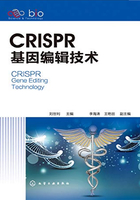
参考文献
[1] Ishino Y, Shinagawa H, Makino K, et al. Nucleotide sequence of the iap gene, responsible for alkaline phosphatase isozyme conversion in Escherichia coli, and identification of the gene product. J Bacteriol, 1987, 169: 5429-5433.
[2] Mojica F J M, Diez-Villaseñor C, García-Martínez J, et al. Intervening sequences of regularly spaced prokaryotic repeats derive from foreign genetic elements. J Mol Evol, 2005, 60: 174-182.
[3] Jansen R, Embden J D A, Gaastra W, et al. Identification of genes that are associated with DNA repeats in prokaryotes. Mol Microbiol, 2002, 43: 1565-1575.
[4] Mohanraju P, Makarova K S, Zetsche B, et al. Diverse evolutionary roots and mechanistic variations of the CRISPR-Cas systems. Science, 2016, 353: 5147.
[5] Jackson S A, McKenzie R E, Fagerlund R D, et al. CRISPR-Cas: adapting to change. Science, 2017, 356: 5056.
[6] Shmakov S, Smargon A, Scott D, et al. Diversity and evolution of class 2 CRISPR-cas systems. Nat Rev Microbiol, 2017, 15: 169-182.
[7] Makarova K S, Wolf Y I, Alkhnbashi O S, et al. An updated evolutionary classification of CRISPR-cas systems. Nat Rev Microbiol, 2015, 13(11): 722.
[8] Hille F, Charpentier E. CRISPR-Cas: biology, mechanisms and relevance. Philos Trans R Soc Lond B Biol Sci, 2016, 371: 1707.
[9] Zhang J H, Adikaram P, Pandey M, et al. Optimization of genome editing through CRISPR-Cas9 engineering. Bioengineered, 2016, 7(3): 166-174.
[10] Deltcheva E, Chylinski K, Sharma C M, et al. CRISPR RNA maturation by trans-encoded small RNA and host factor RNase Ⅲ. Nature, 2011, 471(7340): 602-607.
[11] Fu Y, Foden J A, Khayter C, et al. High-frequency offtarget mutagenesis induced by CRISPR-Cas nucleases in human cells. Nat Biotechnol, 2013, 31(9): 822-826.
[12] Nakade S, Yamamoto T, Sakuma T. Cas9, Cpf1 and C2c1/2/3-What’s next? Bioengineered, 2017, 8(3): 265-273.
[13] Kleinstiver B P, Pattanayak V, Prew M S, et al. High-fidelity CRISPR-Cas9 nucleases with no detectable genomewide off-target effects. Nature, 2016, 529(7587): 490-495.
[14] Kleinstiver B P, Prew M S, Tsai S Q, et al. Engineered CRISPR-Cas9 nucleases with altered PAM specificities. Nature, 2015, 523(7561): 481-485.
[15] Ran F A, Hsu P D, Lin C Y, et al. Double nicking by RNA-guided CRISPR Cas9 for enhanced genome editing specificity. Cell, 2013, 155: 479-480.
[16] Ran F A, Cong L, Yan W X, et al. In vivo genome editing using staphylococcus aureus Cas9. Nature, 2015, 520(7546): 186-191.
[17] Zetsche B, Gootenberg J S, Abudayyeh O O, et al. Cpf1 is a single RNA-guided endonuclease of a class 2 CRISPR-Cas system. Cell, 2015, 163: 759-771.
[18] Scheben A, Wolter F, Batley J, et al. Towards CRISPR/Cas crops - bringing together genomics and genome editing. New Phytol, 2017, 216(3): 682-698.
[19] Cong, L, Ran F A, Cox D, et al. Multiplex genome engineering using CRISPR/Cas systems. Science, 2013, 339: 819-823.
[20] Abudayyeh O O, Gootenberg J S, Essletzbichler P, et al. RNA targeting with CRISPR-Cas13. Nature, 2017, 550 (7675): 280.
[21] Cox D B T, Gootenberg J S, Abudayyeh O O, et al. RNA editing with CRISPR-Cas13. Science, 2017, 358 (6366): 1019-1027.
[22] O’Connell M R, Oakes B L, Sternberg S H, et al. Programmable RNA recognition and cleavage by CRISPR/Cas9. Nature, 2014, 516(7530): 263-266.
[23] Nelles D A, Fang M Y, O’Connell M R, et al. Programmable RNA tracking in live cells with CRISPR/Cas9. Cell, 2016, 165(2): 488-496.
[24] Lundh M, Pluciñska K, Isidor M S, et al. Bidirectional manipulation of gene expression in adipocytes using CRISPRa and siRNA. Mol Metab, 2017, 6: 1313-1320.
[25] Lo A, Qi L. Genetic and epigenetic control of gene expression by CRISPR-cas systems. F1000, 2017, 6: Faculty Rev-747.
[26] Gilbert L A, Horlbeck M A, Adamson B, et al. Genome scale CRISPR-mediated control of gene repression and activation. Cell, 2014, 159: 647-661.
[27] Qi L S, Larson M H, Gilbert L A, et al. Repurposing CRISPR as an RNA-guided platform for sequence-specific control of gene expression. Cell, 2013, 152: 1173-1183.
[28] Jost M, Chen Y, Gilbert L A, et al. Combined CRISPRi/a-based chemical genetic screens reveal that rigosertib is a microtubule-destabilizing agent. Mol Cel, 2017, 68 (1): 210-223.
[29] Kampmann M. CRISPRi and CRISPRa screens in mammalian cells for precision biology and medicine. ACS Chem Biol, 2017, 13: 406-416.
[30] Chen B, Gilbert L A, Cimini B A, et al. Dynamic imaging of genomic loci in living human cells by an optimized CRISPR/Cas system. Cell, 2013, 155: 1479-1491.
[31] Ma H, Naseri A, Reyes-Gutierrez P, et al. Multicolor CRISPR labeling of chromosomal loci in human cells. Proc Natl Acad Sci USA, 2015, 112: 3002-3007.
[32] Klug A. The discovery of zinc fingers and their applications in gene regulation and genome manipulation. Annu Rev Biochem, 2010, 79: 213-231.
[33] Li T, Huang S, Jiang W Z, et al. TAL nucleases (TALNs): hybrid proteins composed of TAL effectors and FokI DNA-cleavage domain. Nucl Acids Res, 2011, 39(1): 359-372.
[34] Brinegar K, Yetisen A, Choi S, et al. The commercialization of genome-editing technologies. Crit Rev Biotechnol, 2017, 37(7): 924-932.
[35] Jinek M, Chylinski K, Fonfara I, et al. A programmable dual-RNA-guided DNA endonuclease in adaptive bacterial immunity. Science, 2012, 337(6096): 816-821.
[36] Ledford H. How the US CRISPR patent probe will play out. Nature, 2016, 531(7593): 149.
[37] Cohen J. Ding, ding, ding! CRISPR patent fight enters next round [Internet], 2017 Jul 26, Am 9: 00. [cited 2017 Dec 29].
[38] CRISPR commercialization risk regenhealthsolutions [Internet]. [cited2017 Dec 29].
[39] Wolter F, Puchta H. Knocking out consumer concerns and regulator’s rules: efficient use of CRISPR/Cas ribonucleoprotein complexes for genome editing in cereals. Genome Biol, 2017, 18: 43.